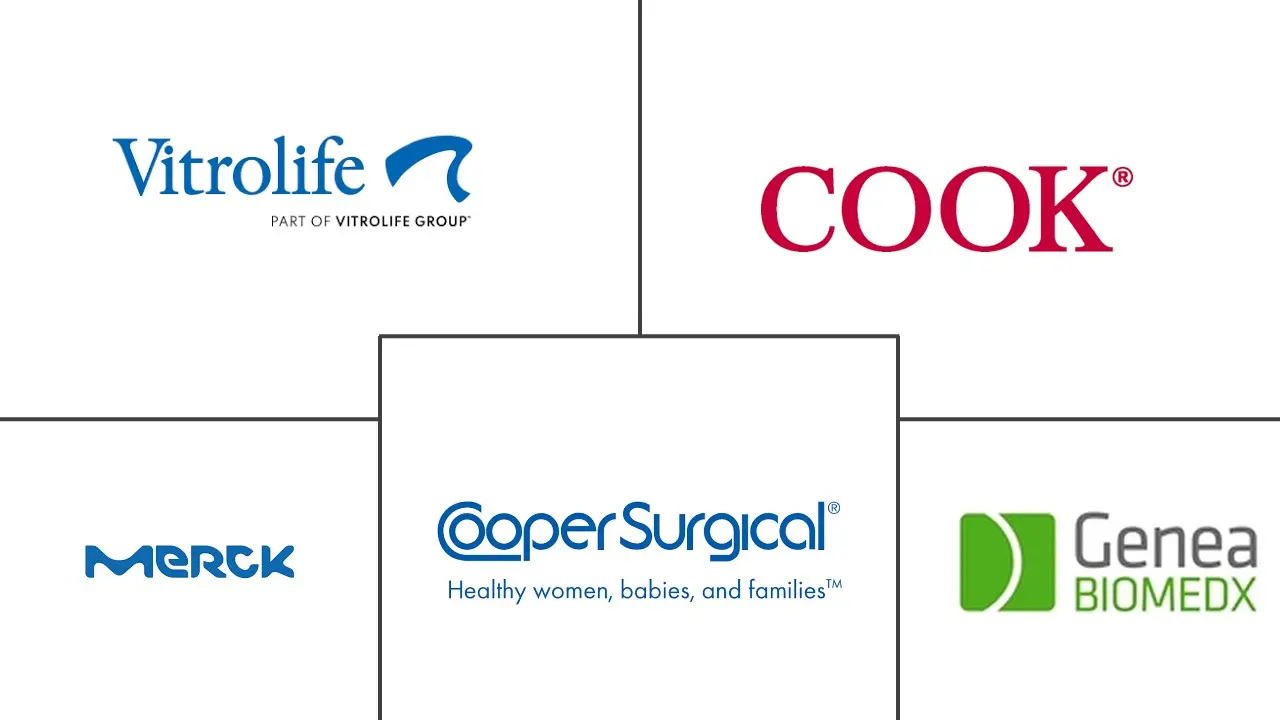In Vitro Fertilization Market Size and Share
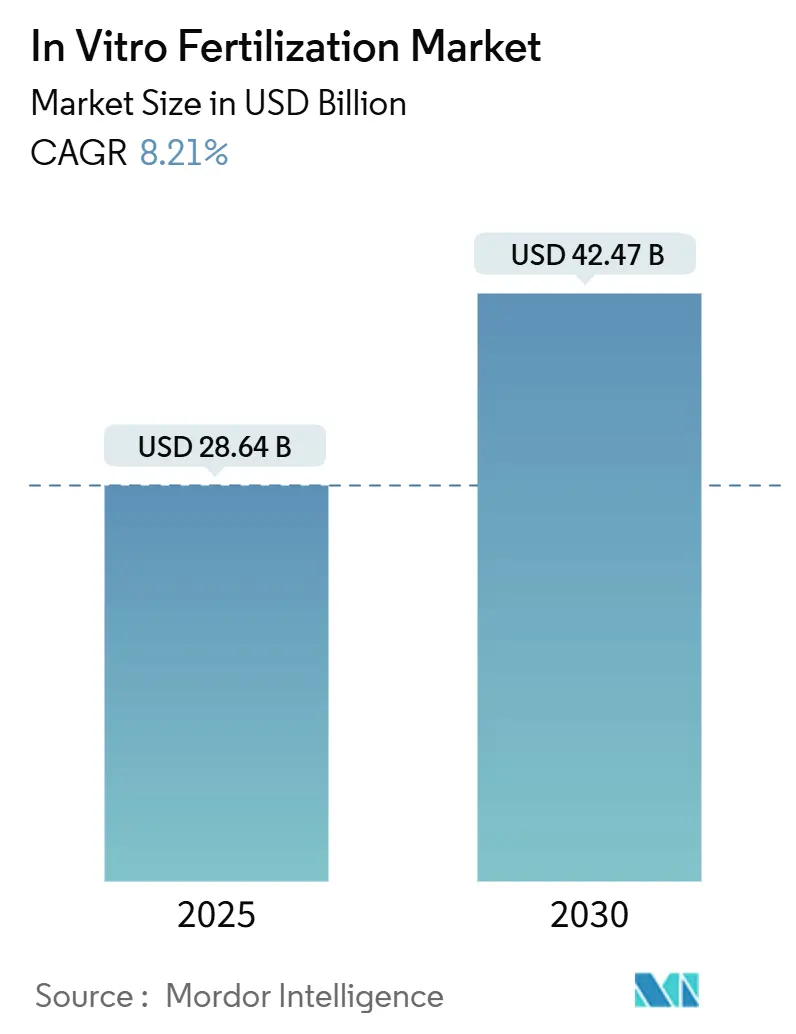
In Vitro Fertilization Market Analysis by Mordor Intelligence
The in vitro fertilization market size is valued at USD 28.64 billion in 2025 and is forecast to reach USD 42.47 billion by 2030, advancing at an 8.21% CAGR. Expanding infertility prevalence, delayed parenthood in developed nations and steady improvements in assisted-reproductive technologies propel this climb. North America leads revenue generation, helped by widening insurance mandates and employer-sponsored fertility benefits, while Asia-Pacific delivers the quickest expansion on the back of medical-tourism inflows and supportive policy changes. Industry participants deepen investments in laboratory automation, non-invasive genetic testing and AI-enabled embryo assessment, which together shorten cycle times and improve success rates. However, high treatment costs, uneven third-party payer coverage and evolving ethical standards surrounding embryo status remain persistent headwinds to adoption.
Key Report Takeaways
- By product category, instruments held 55.67% of the in vitro fertilization market share in 2024; consumables & disposables are projected to post a 10.45% CAGR through 2030.
- By cycle type, fresh IVF cycles – non-donor accounted for 32.14% of the in vitro fertilization market size in 2024, while donor egg cycles are forecast to grow at 10.33% CAGR to 2030.
- By procedure type, conventional IVF commanded 35.67% share of the in vitro fertilization market size in 2024, whereas IVF with PGT/PGD is set to expand at a 9.67% CAGR between 2025–2030.
- By end user, fertility clinics led with a 59.76% share in 2024 and are advancing at an 11.43% CAGR through 2030.
- By geography, North America generated 42.45% of 2024 revenue; Asia-Pacific is projected to record the highest regional CAGR of 9.54% to 2030.
Global In Vitro Fertilization Market Trends and Insights
Driver Impact Analysis
| Driver | (~) % Impact on CAGR Forecast | Geographic Relevance | Impact Timeline |
|---|---|---|---|
| Increasing infertility prevalence | +2.1% | Global, strongest in Asia-Pacific and Europe | Long term (≥ 4 years) |
| Rising average maternal age | +1.8% | North America and Europe; growing in APAC cities | Medium term (2-4 years) |
| Technological advances in assisted reproduction | +1.5% | Global, led by North America and Europe | Short term (≤ 2 years) |
| Growing acceptance of non-traditional families | +1.2% | North America and Europe; emerging in APAC | Medium term (2-4 years) |
| Source: Mordor Intelligence | |||
Increasing Infertility Prevalence
Secondary infertility now surpasses primary infertility across much of Asia-Pacific, largely due to rising polycystic ovary syndrome incidence and lifestyle factors. China has up to 11.8 million infertile couples and as many as 1.9 million new cases each year. Similar trends in the Philippines and urban India are prompting rapid capacity additions, with more than 60 fertility centers opening annually across India. Because infertility is treated as essential rather than discretionary care, demand demonstrates resilience to economic cycles and underpins steady procedure volumes globally.
Rising Average Maternal Age
Women increasingly pursue parenthood in their late-30s and 40s, ages where natural fecundity drops sharply. Studies from the University of Copenhagen show that a higher count of primitive endoderm stem cells in early embryos correlates with greater implantation success, critical for older patients. Declining genetic-testing costs enable pre-implantation screening to spread from fewer than 6% to roughly 25% of all cycles, while oocyte-rejuvenation techniques under development in Singapore aim to restore aged-egg competence. Corporate fertility benefits mirror this societal change, with nearly one-third of US employers now offering IVF coverages.
Technological Advances in Assisted Reproductive Technologies
AI-guided embryo-selection systems such as STORK-A achieve 70% accuracy in predicting aneuploidy, potentially curbing the need for invasive biopsies[1]C. Angelo, “AI Tool STORK-A Improves Embryo Selection,” NewYork-Presbyterian, nyp.org. Robotics have reached proof-of-concept, highlighted by the first baby born from a robot-controlled ICSI procedure completed in Mexico while technicians operated equipment from New York. Malmö-University research further reveals that machine-learning oversight of incubator environment can correct micro-fluctuations harmful to embryo viability. Although some randomized trials find limited benefit from time-lapse imaging, the consensus is that validated automation and predictive analytics can lift clinic throughput and patient outcomes over the near term.
Growing Acceptance of Non-Traditional Family Structures
California’s SB 729 mandates coverage for LGBTQ+ individuals and single parents, broadening the insured population by removing the previous need for an infertility diagnosis[2]“Decision 123/2024,” Alabama Supreme Court, alacourt.gov. Federal rule changes in the United States now allow unmarried veterans to access IVF using donor gametes. Scientific progress in in-vitro gametogenesis holds promise for enabling same-sex couples to conceive genetically related children within the next decade. Together, these policy and social shifts expand the reachable client base for clinics worldwide.
Restraints Impact Analysis
| Restraints Impact Analysis | (~) % Impact on CAGR Forecast | Geographic Relevance | Impact Timeline |
|---|---|---|---|
| High treatment cost and limited insurance coverage | −1.8% | Global; most acute in emerging markets and US uninsured segments | Short term (≤ 2 years) |
| Ethical and religious concerns over embryo manipulation | −0.9% | North America, Middle East, parts of Europe | Long term (≥ 4 years) |
| Stringent regulatory frameworks and compliance burden | −1.0% | Global, with varying national requirements | Medium term (2-4 years) |
| Health risks and variable success rates of IVF procedures | −0.8% | Global | Short term (≤ 2 years) |
| Source: Mordor Intelligence | |||
High Treatment Cost and Patchy Insurance Coverage
Typical US cycle prices range from USD 12,000 to USD 30,000, and total outlays can top USD 60,000 when multiple attempts are needed, pushing many patients to seek treatment in lower-cost hubs such as Singapore or India. California’s upcoming mandate is expected to raise insurer costs by hundreds of millions of dollars annually, potentially inflating premiums. In China, actuarial studies estimate that adding ART to the public insurance catalogue would consume up to 6% of current fund balances, illustrating the fiscal hurdles to universal coverage. Payment-on-success models, including USD 15,000 “live-birth or no-pay” packages marketed by automation start-ups, aim to ease affordability but remain in early stages of adoption.
Ethical and Religious Concerns Over Embryo Manipulation
The Alabama Supreme Court’s 2024 ruling that recognizes frozen embryos as legal persons has prompted reassessments of storage and disposal protocols in clinics across the United States[3]“Senate Bill 729,” Pacific Fertility Center, pacificfertilitycenter.com. Several jurisdictions restrict surrogacy or limit pre-implantation genetic testing to serious disease screening, slowing technology diffusion. Surveys led by Harvard researchers show public ambivalence toward polygenic screening for non-medical traits, with concerns over equity and unintended societal effects. Such debates keep regulatory pathways fluid and add compliance complexity for care providers.
Segment Analysis
By Product: Instruments Lead Despite Consumables Acceleration
Instruments contributed USD 16 billion of 2024 revenue, equal to 55.67% in vitro fertilization market share. Continued capital spending on incubators, micromanipulators and imaging systems sustains this lead even as replacement cycles lengthen. The consumables category, however, is projected to post a brisk 10.45% CAGR, the fastest within the entire in vitro fertilization market. Adoption of sterile, single-use culture ware mitigates contamination risk and dovetails with fully enclosed work-stations that minimize manual handling. Advanced incubators integrate AI algorithms to auto-correct temperature and pH fluctuations every 10 minutes, raising blastocyst yield rates in early commercial deployments. Specialized reagents incorporating glycan-coated micro-beads mimic oviduct conditions and boost sperm viability; yet their incremental cost keeps the overall reagent segment in mature-growth territory. Complementary imaging modules such as EmbryoScope+ now capture nearly 7,200 minutes of time-lapse data per cycle, feeding machine-learning models that rank embryo competence.
The consumables boom reinforces recurring revenue models for suppliers who historically depended on one-off equipment sales. Investments in automated cryo-systems and vitrification media improve post-thaw survival to above 95%, supporting elective single-embryo transfer guidelines aimed at lowering multiple-birth complications. Greater standardization also appeals to networks operating in multiple jurisdictions, where harmonized protocols speed accreditation and insurer contracting. As a result, the in vitro fertilization market size linked to consumables is poised to outstrip instrument spending growth over the forecast period.
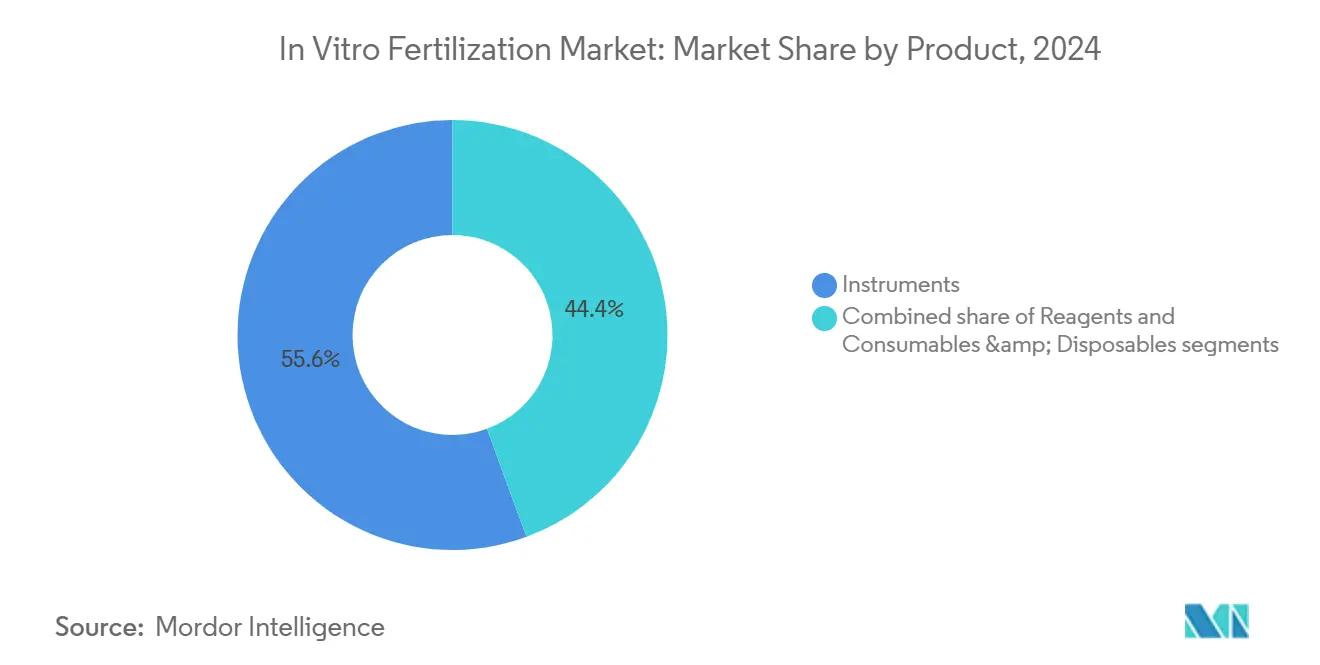
Note: Segment shares of all individual segments available upon report purchase
By Cycle Type: Fresh Cycles Dominate Amid Donor Growth
Fresh non-donor cycles represented 32.14% of completed procedures in 2024, retaining primacy due to immediate transfer and lower storage costs. Enhanced ovarian-stimulation protocols and real-time embryo-grading software keep their success rates competitive, ensuring they remain the backbone of the in vitro fertilization market. Donor egg cycles, though, will expand at 10.33% CAGR as delayed motherhood elevates demand for higher-quality oocytes. Countries with permissive donor legislation and strong clinical infrastructures, such as Spain and the United States, attract growing medical-tourism flows for these services. Frozen-thawed cycles gain ground thanks to refined vitrification and the clinical shift toward single-embryo transfer, which lowers twin-birth risk and neonatal complications.
Donor-sperm cycles are likewise rising in tandem with increasing acceptance of single motherhood and same-sex parenting. Regulatory scrutiny has tightened after isolated incidents of specimen mislabeling, prompting wider deployment of RFID-based chain-of-identity systems. Ethical sourcing and enhanced donor-screening standards reduce reputational risk for clinics and gamete banks, supporting long-term growth in this portion of the in vitro fertilization industry.
By Procedure Type: Conventional Methods Face ICSI Competition
Conventional IVF held 35.67% of 2024 cycles, bolstered by simplicity and broad clinician familiarity. Yet intracytoplasmic sperm injection continues to capture share, particularly for male-factor infertility, and now accounts for roughly one in three procedures worldwide. Automation milestones, including the first robot-operated ICSI live birth, showcase the promise of standardized micromanipulation that could lift global success rates beyond the present 30-50% band. Genetic-testing-augmented IVF remains the fastest-growing procedure subset with a 9.67% CAGR, underpinned by declining sequencing costs and rising patient demand for chromosomal normality assurance. Non-invasive spent-media diagnostics in late-stage validation may push uptake further by eliminating embryo biopsy concerns. Mini-IVF and natural-cycle IVF supply gentler alternatives but require patient counselling to manage their lower per-cycle success probability.
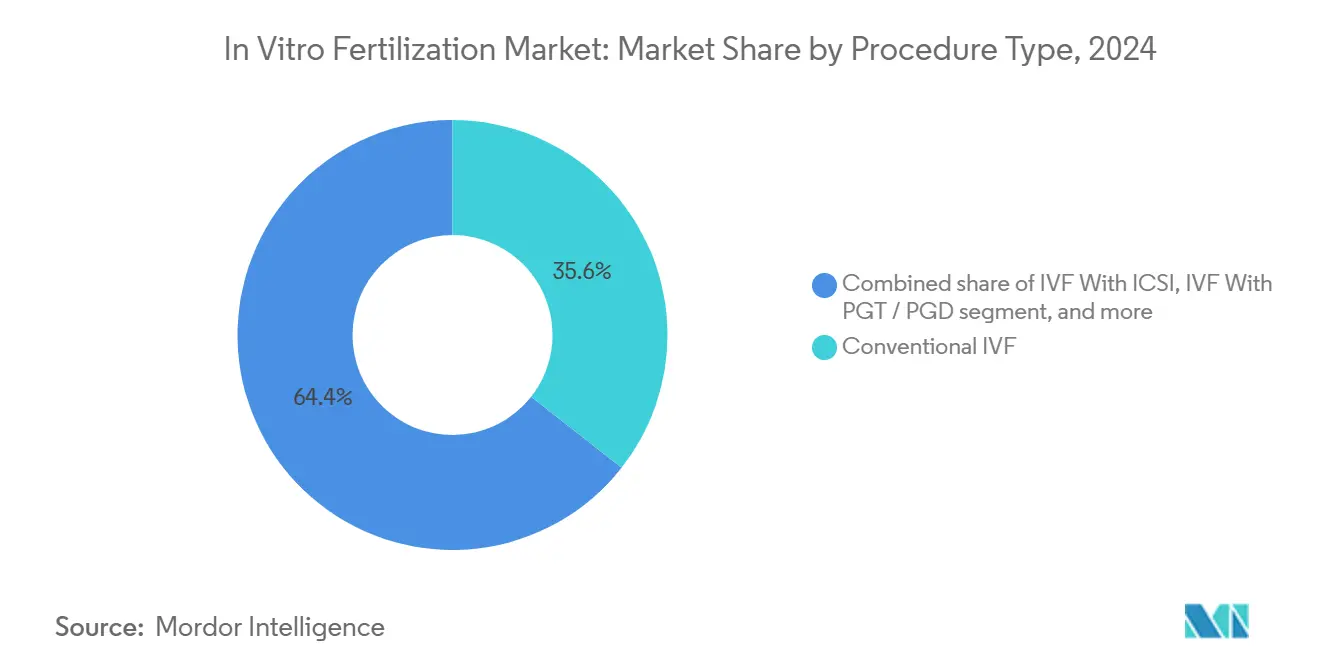
Note: Segment shares of all individual segments available upon report purchase
By End User: Fertility Clinics Consolidate Market Leadership
Dedicated clinics generated 59.76% of global revenue in 2024 and are forecast to grow 11.43% annually through 2030 as private-equity inflows accelerate chain roll-ups. Large platforms benefit from centralized investment in AI analytics, quality-management systems and payer-contracting expertise. For example, the acquisition of Reproductive Medicine Associates of New York by a network operator expanded its footprint to more than 100 sites across the United States, enabling bulk purchasing and unified electronic-health-record deployment. Hospitals and surgical centers retain an important foothold for complex comorbidity cases that demand multi-disciplinary resources, although reimbursement constraints limit their growth pace relative to specialized providers. Cryobanks and research laboratories fill an essential back-end role storing more than 1 million embryos and gamete samples worldwide, a figure that will rise steadily as elective egg freezing normalizes among women in their late-20s.
Geography Analysis
North America captured 42.45% of 2024 revenue, reflecting mature insurance markets, robust corporate fertility benefits and a leadership position in AI-driven laboratory technology. California’s comprehensive SB 729 mandate, effective July 2025, exemplifies the region’s regulatory support: it obliges large group health plans to cover up to three egg retrievals and unlimited transfers. Innovation clusters in the United States host first-in-human trials of autonomous micromanipulation and non-invasive genome screening tools, helping clinics command premium pricing. Nonetheless, divergent state-level rulings on embryo status inject operational uncertainty and may spur patient outflows to more permissive jurisdictions.
Asia-Pacific registers the fastest expansion at a projected 9.54% CAGR through 2030, with regional in vitro fertilization market size expected to top USD 13.5 billion by 2028. China confronts an estimated 11.8 million infertile couples and is evaluating integration of ART into social insurance, a move that would entail initial outlays equal to as much as 6% of current fund balances. India, buoyed by the Assisted Reproduction Technology Act and strong private-equity appetite, is on track to lift service revenue nearly fourfold between 2020 and 2030. Medical tourism flourishes, as Singapore’s average cycle price of USD 10,200 stands at nearly quadruple the USD 2,700 prevailing in major Indian metros, prompting cross-border patient flows into lower-cost destinations.
Europe delivers steady growth anchored by universal healthcare frameworks and favorable reimbursement in select nations. Norway, for instance, subsidizes up to three cycles per woman, while countries such as Spain leverage liberal donor-egg regulations and modern clinic infrastructure to attract international clientele. Eastern European providers offer mid-price alternatives in the EUR 1,600–5,800 range that appeal to Western Europeans seeking shorter waiting lists. Harmonized safety protocols set by the European Society of Human Reproduction and Embryology bolster patient confidence and sustain medical-tourism inflows despite varied national age and embryo-limit rules.
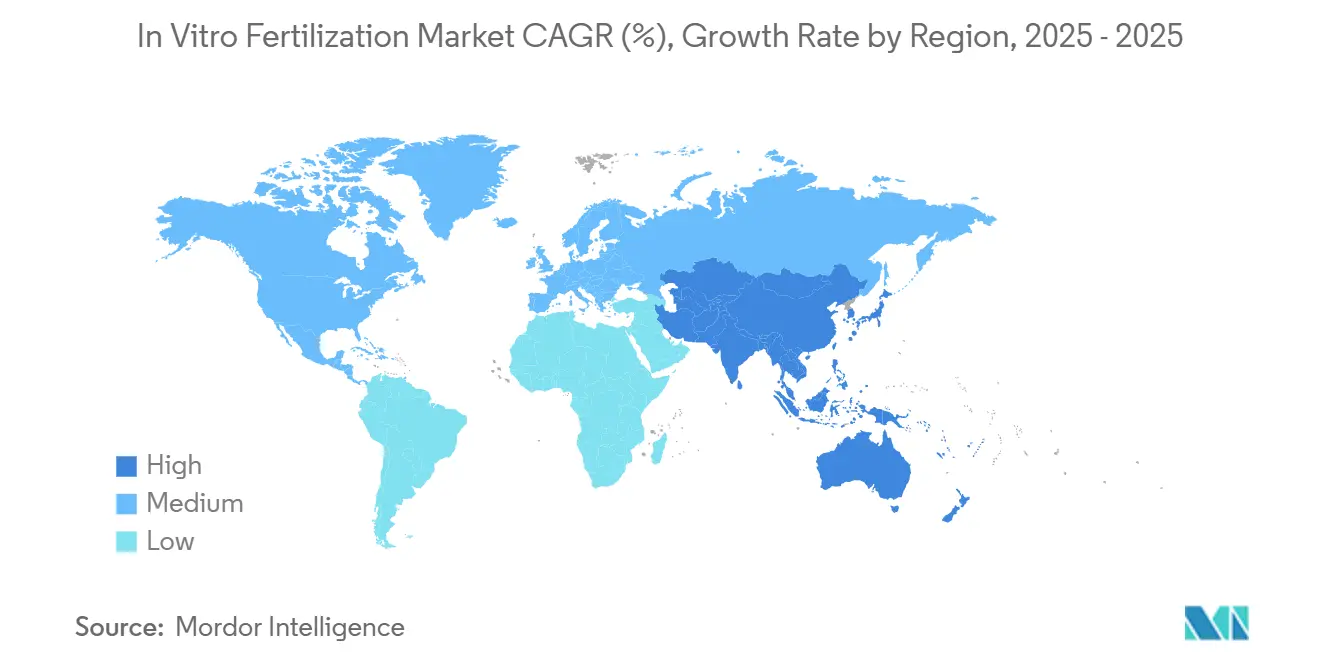
Competitive Landscape
The in vitro fertilization market shows moderate fragmentation but growing consolidation momentum. Global equipment and consumable suppliers increasingly pair with clinic chains to deliver integrated platforms covering every step from stimulation drugs to cryostorage. Vertical mergers, such as Astorg’s purchase of both Hamilton Thorne and Cook Medical’s IVF division, highlight a push to combine instruments and single-use product portfolios under one roof. Technology differentiation, especially around AI scoring of embryos and closed-system work-stations, provides a widening performance gap that favors scaled incumbents able to fund clinical validation studies.
Clinical networks pursue geographic roll-ups to secure payer contracts and spread R&D overhead. Private capital continues to flow: valuations reach double-digit EBITDA multiples for chains with documented live-birth rates above 50% per cycle. Outcome-based pricing, still niche, is gaining notice as automation lowers procedure-cost variability. However, premium hardware vendors face scrutiny after a landmark trial found no improvement in live-birth rates from time-lapse imaging alone, emphasizing the need for robust evidence before widespread adoption.
Disruptive entrants focus on male-infertility diagnostics, non-invasive genetic testing and smartphone-enabled home semen collection. Barriers to entry remain high given complex regulatory approvals and the trust premium patients place on established clinics. Net, the top five players together control roughly 35–40% of global revenue, a level indicative of a mid-concentration structure open to further deal-making.
In Vitro Fertilization Industry Leaders
-
Vitrolife AB
-
CooperSurgical Inc.
-
Merck KGaA
-
Genea Biomedx Pty Ltd
-
Cook Group Incorporated
- *Disclaimer: Major Players sorted in no particular order
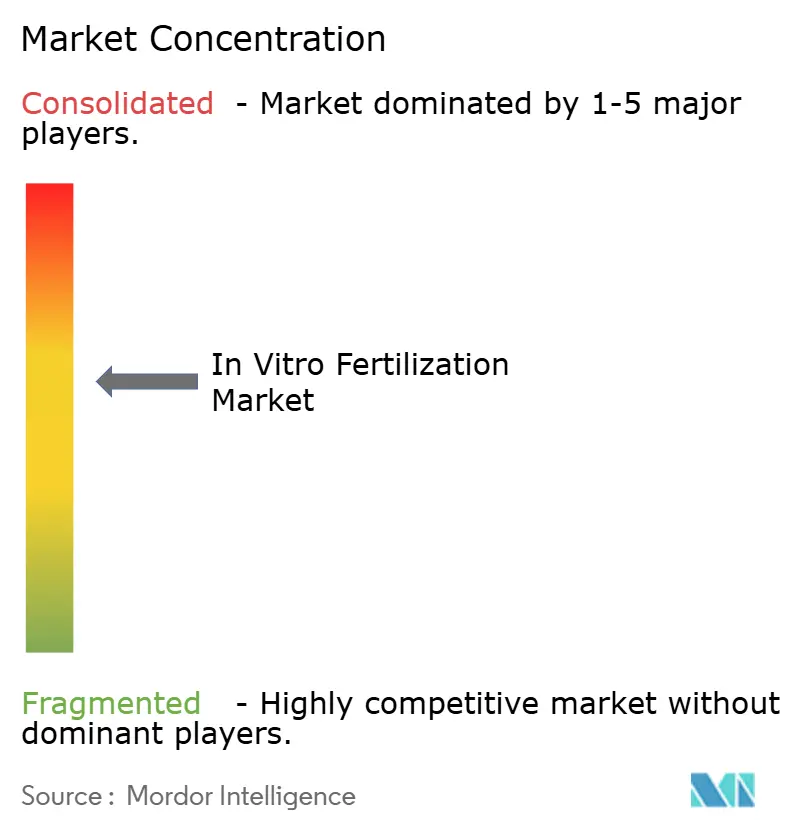
Recent Industry Developments
- June 2025: Gameto secured FDA clearance to begin Phase III trials of its iPSC-derived Fertilo protocol aimed at reducing hormone loads and shortening cycle length to less than 3 days.
- April 2025: : A US executive order expanded in vitro fertilization access for military personnel and veterans, prioritizing federal funding for procedures at Veterans Affairs facilities.
- February 2025: Overture Life raised USD 20.6 million to commercialize automated IVF work-stations focused on lowering per-cycle labor cost.
- January 2025: Astorg finalized the USD 228 million acquisition of Hamilton Thorne and Cook Medical’s IVF unit, creating a combined equipment–consumables platform.
- October 2024: BPEA EQT bought India’s Indira IVF for approximately USD 657 million, marking one of Asia’s largest fertility-clinic deals to date.
Research Methodology Framework and Report Scope
Market Definitions and Key Coverage
Our study views the in-vitro fertilization market as every commercial good or paid service directly enabling human IVF cycles, such as culture media, disposable labware, capital equipment, genetic testing add-ons, cycle fees, and post-transfer clinical visits, delivered through clinics, hospitals, and cryobank networks worldwide. According to Mordor Intelligence, valuation begins once ovarian stimulation medications are dispensed and ends with the embryo-transfer visit; follow-up pregnancy care lies outside this boundary.
Scope exclusion: veterinary reproductive services, hormonal contraceptives, and home-use fertility trackers are not counted.
Segmentation Overview
- By Product
- Reagents
- Instruments
- Imaging Systems
- Incubators
- Cryosystems
- IVF Workstations & Cabinets
- Ovum Aspiration Pumps
- Sperm Separation Systems
- Micromanipulator Systems
- Other Instruments
- Consumables & Disposables
- By Cycle Type
- Fresh IVF Cycles - Non-Donor
- Thawed / Frozen IVF Cycles - Non-Donor
- Donor Egg IVF Cycles
- Donor Sperm IVF Cycles
- By Procedure Type
- Conventional IVF
- IVF With ICSI
- IVF With PGT / PGD
- Mini-IVF & Natural-Cycle IVF
- By End User
- Fertility Clinics
- Hospitals & Surgical Centers
- Cryobanks & Research Laboratories
- Geography
- North America
- United States
- Canada
- Mexico
- Europe
- Germany
- United Kingdom
- France
- Italy
- Spain
- Rest of Europe
- Asia-Pacific
- China
- Japan
- India
- Australia
- South Korea
- Rest of Asia-Pacific
- Middle East & Africa
- GCC
- South Africa
- Rest of Middle East & Africa
- South America
- Brazil
- Argentina
- Rest of South America
- North America
Detailed Research Methodology and Data Validation
Primary Research
Mordor analysts interview embryologists, reproductive endocrinologists, cryobank managers, and payor medical-policy leads across North America, Europe, Asia-Pacific, and the GCC region. Discussions clarify cycle-mix shifts, such as fresh versus frozen, average selling prices for media and disposables, and patient-financing uptake, which we then use to challenge secondary numbers and refine assumptions.
Desk Research
We begin by mapping national IVF cycle volumes, reimbursement rules, and equipment sales using open datasets from bodies such as the WHO infertility portal, CDC ART Registry, Eurostat, Japan's ART Council, and India's NARI dashboard. Trade groups, including the European Society of Human Reproduction and Embryology and the Asian Pacific Initiative on Reproduction, supply conference abstracts on success rates and lab practice trends. Public filings from listed clinic chains, patent analytics from Questel, and news archives in Dow Jones Factiva enrich cost and technology adoption benchmarks. The sources cited above are illustrative, not exhaustive; many additional references underpin each data point.
Market-Sizing & Forecasting
A top-down build starts with recorded IVF cycles by country and multiplies them by validated average revenue per cycle, which is then reconciled with bottom-up cross-checks, such as sampled equipment shipments and culture-media volumes. Key variables tracked include maternal age distribution, infertility prevalence, elective egg-freezing demand, reimbursement penetration, and average media price erosion. Forecasts for 2025 to 2030 are produced through multivariate regression blended with scenario analysis to accommodate policy or technological shocks; coefficients are stress-tested with clinicians before finalization. Data gaps in smaller economies are bridged using regional adoption ratios anchored to GDP per capita and insurance coverage.
Data Validation & Update Cycle
Outputs pass a four-layer review: analyst self-audit, senior peer check, sector lead approval, and final QA before sign-off. We refresh every twelve months, while material changes, for example, new national insurance mandates, trigger interim revisions and rapid stakeholder callbacks.
Credibility Anchor: Why Our In Vitro Fertilization Baseline Earns Trust
Published estimates often diverge because firms choose different product baskets, year anchors, and refresh speeds.
Below, we benchmark Mordor's 2025 value against external figures and note the research gaps that create variance.
Benchmark comparison
| Market Size | Anonymized source | Primary gap driver |
|---|---|---|
| USD 28.64 bn (2025) | Mordor Intelligence | - |
| USD 27.10 bn (2024) | Regional Consultancy A | Excludes cryopreservation accessories and relies on 2022 clinic volumes, so growth uplift is understated. |
| USD 29.51 bn (2024) | Trade Journal B | Combines surrogacy and fertility preservation revenues, inflating base; limited primary validation reported. |
These contrasts show that when scope creep or dated inputs slip in, totals drift quickly. By tying every dollar to transparent cycle counts, current ASPs, and yearly expert reviews, Mordor Intelligence delivers a balanced, reproducible baseline executives can rely on for investment and capacity decisions.
Key Questions Answered in the Report
What is the current size of the in vitro fertilization market?
The global in vitro fertilization market is valued at USD 28.64 billion in 2025 and is projected to reach USD 42.47 billion by 2030.
Which region leads IVF revenue today?
North America holds the largest share at 42.45% of 2024 global revenue due to broadening insurance mandates and strong technology adoption.
Why is Asia-Pacific the fastest-growing IVF region?
Rising infertility prevalence, favorable policy changes and medical-tourism inflows are driving a 9.54% CAGR for Asia-Pacific through 2030.
Which product category is expanding fastest?
Consumables & disposables are forecast to grow 10.45% annually as clinics shift toward single-use, contamination-reducing supplies.
How is technology changing IVF success rates?
AI embryo-selection tools and robotic micromanipulation are improving accuracy and consistency, with some systems predicting aneuploidy at 70% accuracy.
What are the main barriers to wider IVF adoption?
High per-cycle costs, uneven insurance coverage and ongoing ethical debates over embryo status remain key obstacles worldwide.
Page last updated on:
